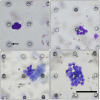Size-based isolation of circulating tumor cells in lung cancer patients using a microcavity array system
- PMID: 23840710
- PMCID: PMC3696066
- DOI: 10.1371/journal.pone.0067466
Size-based isolation of circulating tumor cells in lung cancer patients using a microcavity array system
Abstract
Background: Epithelial cell adhesion molecule (EpCAM)-based enumeration of circulating tumor cells (CTC) has prognostic value in patients with solid tumors, such as advanced breast, colon, and prostate cancer. However, poor sensitivity has been reported for non-small cell lung cancer (NSCLC). To address this problem, we developed a microcavity array (MCA) system integrated with a miniaturized device for CTC isolation without relying on EpCAM expression. Here, we report the results of a clinical study on CTCs of advanced lung cancer patients in which we compared the MCA system with the CellSearch system, which employs the conventional EpCAM-based method.
Methods: Paired peripheral blood samples were collected from 43 metastatic lung cancer patients to enumerate CTCs using the CellSearch system according to the manufacturer's protocol and the MCA system by immunolabeling and cytomorphological analysis. The presence of CTCs was assessed blindly and independently by both systems.
Results: CTCs were detected in 17 of 22 NSCLC patients using the MCA system versus 7 of 22 patients using the CellSearch system. On the other hand, CTCs were detected in 20 of 21 small cell lung cancer (SCLC) patients using the MCA system versus 12 of 21 patients using the CellSearch system. Significantly more CTCs in NSCLC patients were detected by the MCA system (median 13, range 0-291 cells/7.5 mL) than by the CellSearch system (median 0, range 0-37 cells/7.5 ml) demonstrating statistical superiority (p = 0.0015). Statistical significance was not reached in SCLC though the trend favoring the MCA system over the CellSearch system was observed (p = 0.2888). The MCA system also isolated CTC clusters from patients who had been identified as CTC negative using the CellSearch system.
Conclusions: The MCA system has a potential to isolate significantly more CTCs and CTC clusters in advanced lung cancer patients compared to the CellSearch system.
Conflict of interest statement
Figures




Similar articles
-
Analysis of circulating tumor cells in patients with non-small cell lung cancer using epithelial marker-dependent and -independent approaches.J Thorac Oncol. 2012 Feb;7(2):306-15. doi: 10.1097/JTO.0b013e31823c5c16. J Thorac Oncol. 2012. PMID: 22173704
-
Development of an automated size-based filtration system for isolation of circulating tumor cells in lung cancer patients.PLoS One. 2017 Jun 22;12(6):e0179744. doi: 10.1371/journal.pone.0179744. eCollection 2017. PLoS One. 2017. PMID: 28640869 Free PMC article.
-
Circulating tumor cell and cell-free RNA capture and expression analysis identify platelet-associated genes in metastatic lung cancer.BMC Cancer. 2019 Jun 19;19(1):603. doi: 10.1186/s12885-019-5795-x. BMC Cancer. 2019. PMID: 31215484 Free PMC article.
-
Mesenchymal-Epithelial Transition and Circulating Tumor Cells in Small Cell Lung Cancer.Adv Exp Med Biol. 2017;994:229-245. doi: 10.1007/978-3-319-55947-6_12. Adv Exp Med Biol. 2017. PMID: 28560677 Review.
-
Circulating tumor cells count as a predictor of survival in lung cancer.Crit Rev Oncol Hematol. 2018 May;125:60-68. doi: 10.1016/j.critrevonc.2018.03.004. Epub 2018 Mar 7. Crit Rev Oncol Hematol. 2018. PMID: 29650278 Review.
Cited by
-
Biochip with multi-planar electrodes geometry for differentiation of non-spherical bioparticles in a microchannel.Sci Rep. 2021 Jun 4;11(1):11880. doi: 10.1038/s41598-021-91109-2. Sci Rep. 2021. PMID: 34088942 Free PMC article.
-
Development and Evaluation of a Quantitative Systems Pharmacology Model for Mechanism Interpretation and Efficacy Prediction of Atezolizumab in Combination with Carboplatin and Nab-Paclitaxel in Patients with Non-Small-Cell Lung Cancer.Pharmaceuticals (Basel). 2024 Feb 12;17(2):238. doi: 10.3390/ph17020238. Pharmaceuticals (Basel). 2024. PMID: 38399453 Free PMC article.
-
Phenotypic Plasticity in Circulating Tumor Cells Is Associated with Poor Response to Therapy in Metastatic Breast Cancer Patients.Cancers (Basel). 2023 Mar 6;15(5):1616. doi: 10.3390/cancers15051616. Cancers (Basel). 2023. PMID: 36900406 Free PMC article.
-
Technologies for circulating tumor cell separation from whole blood.J Hematol Oncol. 2019 May 14;12(1):48. doi: 10.1186/s13045-019-0735-4. J Hematol Oncol. 2019. PMID: 31088479 Free PMC article. Review.
-
Microfluidic systems for hydrodynamic trapping of cells and clusters.Biomicrofluidics. 2020 May 20;14(3):031502. doi: 10.1063/5.0002866. eCollection 2020 May. Biomicrofluidics. 2020. PMID: 34992704 Free PMC article. Review.
References
-
- Maemondo M, Inoue A, Kobayashi K, Sugawara S, Oizumi S, et al. (2010) Gefitinib or chemotherapy for non-small-cell lung cancer with mutated EGFR. N Engl J Med 362: 2380–2388. - PubMed
-
- Cristofanilli M, Budd GT, Ellis MJ, Stopeck A, Matera J, et al. (2004) Circulating tumor cells, disease progression, and survival in metastatic breast cancer. N Engl J Med 351: 781–791. - PubMed
-
- Cohen SJ, Punt CJ, Iannotti N, Saidman BH, Sabbath KD, et al. (2008) Relationship of circulating tumor cells to tumor response, progression-free survival, and overall survival in patients with metastatic colorectal cancer. J Clin Oncol 26: 3213–3221. - PubMed
-
- de Bono JS, Scher HI, Montgomery RB, Parker C, Miller MC, et al. (2008) Circulating tumor cells predict survival benefit from treatment in metastatic castration-resistant prostate cancer. Clin Cancer Res 14: 6302–6309. - PubMed
Publication types
MeSH terms
Substances
LinkOut - more resources
Full Text Sources
Other Literature Sources
Medical
Research Materials
Miscellaneous

